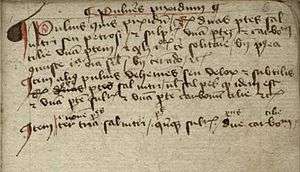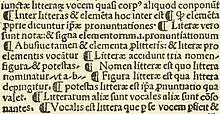Pilcrow
The pilcrow, ¶, also called the paragraph mark, paragraph sign, paraph, alinea (Latin: a lineā, "off the line"), or blind P,[3] is a typographical character marking the start of a paragraph.
| ¶ | |
|---|---|
Pilcrow | |
| In Unicode | U+00B6 ¶ PILCROW SIGN (HTML ¶ · ¶) |
| Related | |
| See also |
|
| Different from | |
| Different from | U+00A7 § SECTION SIGN |



The pilcrow may be used at the start of separate paragraphs or to designate a new paragraph in one long piece of copy, as Eric Gill did in his 1931 book An Essay on Typography.[4] The pilcrow was a type of rubrication used in the Middle Ages to mark a new train of thought, before the convention of visually discrete paragraphs was commonplace.[5]
The pilcrow is usually drawn similar to a lowercase q reaching from descender to ascender height; the loop can be filled or unfilled. It may also be drawn with the bowl stretching further downwards, resembling a backwards D; this is more often seen in older printing.
Origin and name
The word pilcrow originates from the Greek word paragraphos. This was rendered in Old French as paragraphe and later changed to pelagraphe. The earliest reference of the modern pilcrow is in 1440 with the Middle English word pylcrafte.[6]
The first way to divide sentences into groups in Ancient Greek was the original paragraphos, which was a horizontal line in the margin to the left of the main text.[7] As the paragraphos became more popular, the horizontal line eventually changed into the Greek letter Gamma (Γ / γ) and later into litterae notabiliores, which were enlarged letters at the beginning of a paragraph.[8] This notation soon changed to the letter ⟨K⟩, an abbreviation for the Latin word kaput, which translates as "head", i.e. it marks the head of a new thesis.[9] Eventually, to mark a new section, the Latin word capitulum, which translates as "little head", was used, and the letter ⟨C⟩ came to mark a new section in 300 BC.[10]
In the 1100s, ⟨C⟩ had completely replaced ⟨K⟩ as the symbol for a new chapter.[2] Rubricators eventually added one or two vertical bars to the C to stylize it (as ⸿); the symbol was filled in with dark ink and eventually looked like the modern pilcrow, ¶.[2]
Modern use
Scribes would often leave space before paragraphs to allow rubricators to draw the pilcrow. With the introduction of the printing press, space before paragraphs was still left for rubricators to draw by hand; however, rubricators could not draw fast enough for printers and often would leave the beginnings of the paragraphs as blank. This is how the indent before paragraphs was created.[11] Nevertheless, the pilcrow remains in use in modern time in the following ways:
- in legal writing, it is often used whenever one cites a specific paragraph within pleadings, law review articles, statutes, or other legal documents and materials;
- in academic writing, it is sometimes used as an in-text referencing tool to make reference to a specific paragraph from a document that does not contain page numbers, allowing the reader to find where that particular idea or statistic was sourced. The pilcrow sign followed by a number indicates the paragraph number from the top of the page. It is rarely used when citing books or journal articles;
- in proofreading, it indicates an instruction that one paragraph should be split into two or more separate paragraphs. The proofreader inserts the pilcrow at the point where a new paragraph should begin;
- in some high-church Anglican and Episcopal churches, it is used in the printed order of service to indicate that instructions follow; these indicate when the congregation should stand, sit, and kneel, who participates in various portions of the service, and similar information. King's College, Cambridge uses this convention in the service booklet for the Festival of Nine Lessons and Carols. This is analogous to the writing of these instructions in red in some rubrication conventions.
The pilcrow is used in desktop publishing software such as desktop word processors and page layout programs to mark the presence of a carriage return control character at the end of a paragraph. It is also used as the icon on a toolbar button that shows or hides the pilcrow and similar hidden characters, including tabs, whitespace, and page breaks. In typing programs, it marks a return that one must type.
The pilcrow may indicate a footnote in a convention using a sequence of distinct typographic symbols in sequence to distinguish the footnotes on a given page; it is the sixth in a series of footnote symbols beginning with the asterisk.[3]
Encoding
The pilcrow character was in the 1984 Multinational Character Set extension of ASCII at 0xB6 (decimal 182), from where it was inherited by ISO/IEC 8859-1 (1987) and thence by Unicode as U+00B6 ¶ PILCROW SIGN. In addition, Unicode also defines U+204B ⁋ REVERSED PILCROW SIGN, U+2761 ❡ CURVED STEM PARAGRAPH SIGN ORNAMENT, and U+2E3F ⸿ CAPITULUM. The capitulum character is obsolete, being replaced by pilcrow, but is included in Unicode for backward compatibility and historic studies.
Historically, the pilcrow symbol was included in the default hardware codepage 437 of IBM PCs (and all other 8-bit OEM codepages based on this) at code point 20 (0x14), sharing its position with the ASCII control code DC4.
Keyboard entry
- US international keyboard layout: AltGr+;
- Windows: Alt+0182 or Alt+20 (both on the numeric keypad)[12]
- Classic Mac OS and macOS: ⌥ Opt+7
- Linux: Compose⇧ Shift+PP
- Linux and Chrome OS: Ctrl+⇧ Shift+UB6 (Chrome-OS with UK-International keyboard layout: AltGr+r).
- HTML:
¶(introduced in HTML 3.2 (1997)), or¶ - Vim, in insert mode: Ctrl+K PI
- TeX:
\P - LaTeX:
\Por\textpilcrow. - Apple iPhones and iPads may require additional software. Tools may be required to easily generate a pilcrow, or other special characters.[13]
- Android phones have the symbol via ?123 then =/< (position may vary by region and language).
Depending on the font used, this character varies in appearance and, exceptionally, may be replaced by an alternate glyph entirely.
Paragraph signs in non-Latin writing systems
In Chinese, the traditional paragraph sign (rendered as 〇) is a thin circle about the same size as a Chinese character. This same mark also serves as a "zero" character, as a stylistic variation of the Chinese character for "zero". As a paragraph sign, this mark only appears in older books, commonly found in the Chinese Union Version of the Bible. Its current use is generally as a "zero" character. However, it can also be found in some editions of the King James Bible and the Book of Mormon.
In Thai, the character U+0E5B ๛ THAI CHARACTER KHOMUT can mark the end of a chapter or document.
In Sanskrit and other Indian languages, text blocks used to be written in stanzas. Two vertical bars <nowiki>||</nowiki> were the functional equivalent of a pilcrow.
References
- Updike, Daniel Berkeley, Printing Type – their History, Forms, and Use, 1922. Vol. I, p. 107.
- M. B. Parkes (1993). "The Development of the General Repertory of Punctuation". Pause and Effect: Punctuation in the West. Berkeley: University of California Press. p. 43. ISBN 9780520079410.
- "Notes, references and bibliographies: Notes". Style manual (3 ed.). Canberra: Australian government publishing service. 1978.
- Eric Gill (2013) [1931]. An Essay on Typography. London: Penguin. ISBN 9780141393568.
- Stamp, Jimmy (10 July 2013). "The Origin of the Pilcrow, aka the Strange Paragraph Symbol". Design Decoded (a Smithsonian blog).
- Keith Houston. "The Pilcrow". Shady characters : ampersands, interrobangs and other typographical curiosities. London: Penguin. p. 16. ISBN 9780718193881.
- Edwin Herbert Lewis (1894). The History of the English Paragraph. University of Chicago Press. p. 9.
- M. B. Parkes (1993). "Introduction: Glossary of Technical Terms". Pause and Effect: Punctuation in the West. Berkeley: University of California Press. p. 10. ISBN 9780520079410.
- M. B. Parkes (1993). "1. Antiquity: Aids for Inexperienced Readers and the Prehistory of Punctuation". Pause and Effect: Punctuation in the West. Berkeley: University of California Press. p. 12. ISBN 9780520079410.
- David Sacks (2003). "K and its Kompetitors". The Alphabet: Unravelling the Mystery of the Alphabet from A to Z. London: Hutchinson. p. 206. ISBN 9780091795061.
- Jan Tschichold; Robert Bringhurst (1991). "Why the Beginnings of Paragraphs Must Be Indented". The form of the book : essays on the morality of good design. Translated by Hajo Hadeler. London: Lund Humphries. pp. 105–109.
- "Windows Alt Key Codes". Penn State University. 2010. Archived from the original on 14 June 2010.
- "iPad Writing Tool". iDevices World – Australia. 2011. Archived from the original on 20 June 2011.
External links
| Look up Pilcrow in Wiktionary, the free dictionary. |